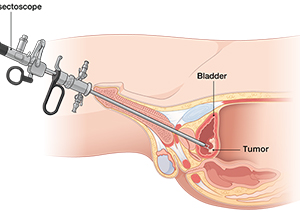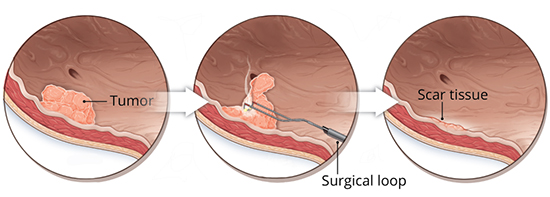
What is the Transurethral Resection of Bladder Tumor (TURBT)?
Transurethral resection of bladder tumor (TURBT) is a procedure used to diagnose bladder cancer and remove any tumor or cancerous tissue from the bladder.
Procedure of Transurethral Resection of Bladder Tumor
TURBT is performed under general or spinal anesthesia. Your surgeon inserts a cystoscope (a thin tube with light and camera fitted at the end) into your bladder, through the urethral opening (natural opening for the outflow of urine) to locate any tumor growth or cancerous tissue in the bladder. An instrument called the resectoscope (a wire loop) is inserted through the cystoscope. Electric current is passed through the wire loop to cut away the cancerous tissue along with a margin of healthy tissue. The complete surgical procedure takes around 15 to 40 minutes.
A catheter (thin, flexible tube) may be inserted into the urethra and left in place for about 24 hours to remove any blood clots formed in your bladder. You may have to stay in the hospital for 1 to 4 days after the surgery. Your doctor may prescribe antibiotics to prevent infection and painkillers to provide relief from post-operative pain.

Complications of Transurethral Resection of Bladder Tumor
TURBT has some risks shared with all surgery of the bladder: risk of urinary tract infection, bleeding in urine, and injury to the structures of the urethra and the bladder. In some cases a hole will be made in the bladder during this surgery. This can be necessary to remove particularly large or deep tumors. If this occurs, you will require a catheter for a longer period of time. In rare circumstances additional surgery may be required to reconstruct the bladder after a large tumor is removed.
Post-Operative Care of Transurethral Resection of Bladder Tumor
After your surgery you will have a catheter to drain your urine. This is usually removed 1-3 days after surgery, depending on the size and location of your tumor. You may have bladder spasms, painful urges to urinate. This usually improve within 1-2 weeks. Your doctor can prescribe you medication to help control these spasms. It is normal to see some blood in your urine after the procedure. It is not normal to pass blood clots and you should call your doctor if you are experiencing this.
In some cases your doctor may recommend a second look procedure 4-6 weeks after your initial surgery. This can be an important part of evaluating and treating bladder cancer.
